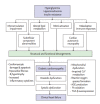Diabetic cardiomyopathy: where we are and where we are going
- PMID: 28415836
- PMCID: PMC5432803
- DOI: 10.3904/kjim.2016.208
Diabetic cardiomyopathy: where we are and where we are going
Abstract
The global burden of diabetes mellitus and its related complications are currently increasing. Diabetes mellitus affects the heart through various mechanisms including microvascular impairment, metabolic disturbance, subcellular component abnormalities, cardiac autonomic dysfunction, and a maladaptive immune response. Eventually, diabetes mellitus can cause functional and structural changes in the myocardium without coronary artery disease, a disorder known as diabetic cardiomyopathy (DCM). There are many diagnostic tools and management options for DCM, although it is difficult to detect its development and effectively prevent its progression. In this review, we summarize the current research regarding the pathophysiology and pathogenesis of DCM. Moreover, we discuss emerging diagnostic evaluation methods and treatment strategies for DCM, which may help our understanding of its underlying mechanisms and facilitate the identification of possible new therapeutic targets.
Keywords: Diabetes mellitus; Diabetic cardiomyopathies; Heart failure.
Conflict of interest statement
No potential conflict of interest relevant to this article was reported.
Figures
References
-
- Trachanas K, Sideris S, Aggeli C, et al. Diabetic cardiomyopathy: from pathophysiology to treatment. Hellenic J Cardiol. 2014;55:411–421. - PubMed
-
- Aneja A, Tang WH, Bansilal S, Garcia MJ, Farkouh ME. Diabetic cardiomyopathy: insights into pathogenesis, diagnostic challenges, and therapeutic options. Am J Med. 2008;121:748–757. - PubMed
Publication types
MeSH terms
LinkOut - more resources
Full Text Sources
Other Literature Sources
Medical

